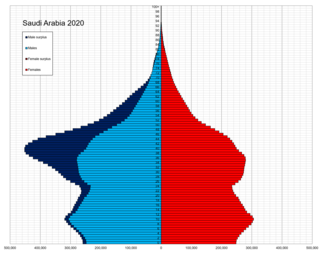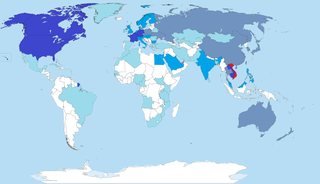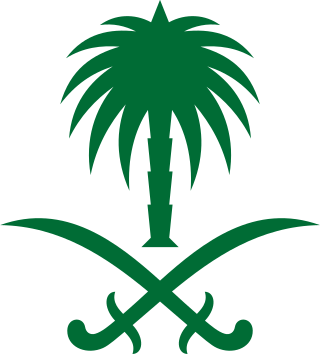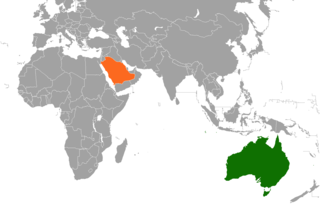
Saudi Arabia is the fourth largest state in the Arab world, with a reported population of 32,175,224 as of 2022. 41.6% of inhabitants are immigrants. Saudi Arabia has experienced a population explosion in the last 40 years, and continues to grow at a rate of 1.62% per year.

Xenophobia is the fear or dislike of anything which is perceived as being foreign or strange. It is an expression which is based on the perception that a conflict exists between an in-group and an out-group and it may manifest itself in suspicion of one group's activities by members of the other group, a desire to eliminate the presence of the group which is the target of suspicion, and fear of losing a national, ethnic, or racial identity.

Saudi Arabia, officially the Kingdom of Saudi Arabia (KSA), is a country in the Middle East. It covers the bulk of the Arabian Peninsula and has a land area of about 2150000 km2, making it the fifth-largest country in Asia and the largest in the Middle East. It is bordered by the Red Sea to the west; Jordan, Iraq, and Kuwait to the north; the Persian Gulf, Qatar and the United Arab Emirates to the east; Oman to the southeast; and Yemen to the south. Bahrain is an island country off its east coast. The Gulf of Aqaba in the northwest separates Saudi Arabia from Egypt and Israel. Saudi Arabia is the only country with a coastline along both the Red Sea and the Persian Gulf, and most of its terrain consists of arid desert, lowland, steppe, and mountains. Saudi Arabia's capital and largest city is Riyadh; the kingdom is also the location of Islam's two holiest cities of Mecca and Medina.

Overseas Vietnamese refers to Vietnamese people who live outside Vietnam. There are approximately 5 million overseas Vietnamese, the largest community of whom live in the United States.

Elections in Saudi Arabia are rare. Municipal elections were last held in 2015, the first time women had the right to vote and stand as candidates.
Laotians in France consist of people of Lao ancestry who were born in or immigrated to France. The population as of 2017 is estimated to be 200,000.
Australian Canadians are Canadian citizens or residents with Australian ancestry. There are three groups of Australian Canadians, including Australian immigrants to Canada, descendants of Australian immigrants to Canada, and Australian expatriates residing in Canada. According to the 2021 Census, there were 46,765 Canadians who claimed full or partial Australian ancestry. Historically, most Australian Canadians lived in the western provinces of Canada, however in 2016, the most popular cities for Australian immigrants are Vancouver and Toronto. While the number of Australian Canadians is quite low relative to other countries, the number of Australians on working visas in Canada is extremely high.

Public education—from primary education through college—is open to every Saudi citizen. Education is the second-largest sector of government spending in Saudi Arabia. Saudi Arabia spends 8.8% of its gross domestic product on education, which is nearly double the global average of 4.6%. Islamic studies are part of the education system alongside scientific and social studies that vary from educational institution to another.
Gender apartheid is the economic and social sexual discrimination against individuals because of their gender or sex. It is a system enforced by using either physical or legal practices to relegate individuals to subordinate positions. Feminist scholar Phyllis Chesler, professor of psychology and women's studies, defines the phenomenon as "practices which condemn girls and women to a separate and subordinate sub-existence and which turn boys and men into the permanent guardians of their female relatives' chastity". Instances of gender apartheid lead not only to the social and economic disempowerment of individuals, but can also result in severe physical harm.
Pakistani Australians are Australians who are of Pakistani descent or heritage. Most Pakistani Australians are Muslims by religion, although there are also sizeable Christian, Hindu and other minorities.

Overseas Pakistanis, or the Pakistani diaspora, refers to Pakistanis who live outside of Pakistan. These include citizens that have migrated to another country as well as people born abroad of Pakistani descent. According to the Ministry of Overseas Pakistanis and Human Resource Development, approximately 8.8 million Pakistanis live abroad according to December 2017 estimates. According to the Ministry of Emigration and Overseas Employment, data released in 2023 states that more than 10.80 million people have moved abroad since 1990. beoe.gov.pk

Women's rights in Saudi Arabia is a topic of concern and controversy internationally. Saudi women have experienced major legal rights reforms since 2017, after facing Wahhabi religious fundamentalist dominance for decades.
Saudi Americans are Americans of total or partial Saudi descent. According to the 2000 census, 7,419 people of Saudi origin were living in the United States. In 2015, according to the American Community Survey, 96,783 Saudi-born people were living in the US. Saudi Arabia and the US have had important political relations since the 1940s. Population estimates are seen to have a very small diaspora, mainly because Saudi Arabia provides native Saudis with more than adequate welfare benefits, removing the need to live and work in other developed countries.
Australians in Saudi Arabia are a sizeable community consisting mainly of expatriates. Their population is estimated to be anywhere up to 5,000 with the majority based in major commercial centres such as Riyadh and Jeddah. Most Australian citizens in Saudi Arabia tend to be occupational-oriented and are employed mainly in the health, education, construction and technology sectors. There are approximately 1,000 Australians who live in Jeddah alone, a city which serves as the country's main port and economic hub. In addition, thousands of Australian Muslims travel and stay in Saudi Arabia each year, often intending to visit the two holiest cities of Islam, Mecca and Medina. Many expatriates in Saudi Arabia are attracted to what they refer to as "the good life", including large salaries and tax-free jobs, consistent weather and a comfortable social life within their housing compounds.
LGBT migration is the movement of lesbian, gay, bisexual and transgender(LGBT) people around the world and domestically, often to escape discrimination or ill treatment due to their sexuality. Globally, many LGBT people attempt to leave discriminatory regions in search of more tolerant ones.
Saudi Arabia is a theocracy organized according to the principles of Islam, which puts emphasis on the importance of knowledge and education. In Islamic belief, obtaining knowledge is the only way to gain true understanding of life, and as such, both men and women are encouraged to study. Saudi Arabia is one of the G20 Economies and has a $1 Trillion GDP. In 2016, it launched one of the most significant programs globally - Vision 2030. In 2021, women's college graduation rates exceeded those of men's.
Syrian Australians are Australians of Syrian descent or Syria-born people who reside in the Commonwealth of Australia. Australian Syrians make up 0.4 percent of the Australian population, with a gender split of 51.3 percent female, 49.7 percent male. The 2016 Australian census revealed 68.8 percent of Syrian Australian homes have Arabic as the language spoken at home, however of the homes where English is not the first spoken language, 37.7 percent are able to speak English fluently. The majority of Syrian Australians arrived prior to 2007, with a small group immigrating between 2007–2011 then a larger group entering between 2012–2016.

Immigrants make up about 13% of the US population, about 42 million out of a total population of 318.9 million citizens in 2017. First and second generation immigrant children have become the fastest-growing segment of the United States population. Compared to the native-born population, young adults aged 15–34 are significantly over-represented in new immigrants. Children and immigrants ages 35–44 are in similar proportion to native-born Americans, but older people are under-represented in new immigrants.

Higher education in Saudi Arabia is the educational stage that follows the three years of secondary education. Higher education institutions are either governmental institutions or private institutions, and are mainly universities, colleges, and academies. There are three higher educational levels in Saudi Arabia: bachelor's degree, master's degree, and doctorate. Governmental universities in Saudi Arabia offer a free bachelor's degree education for Saudis and a monthly payment for each student during their studying period.

Bilateral relations exist between Australia and Saudi Arabia. Australia has an embassy in Riyadh and a consulate in Jeddah; and Saudi Arabia has an embassy in Canberra and a consulate in Sydney. The two countries are members of G20.













